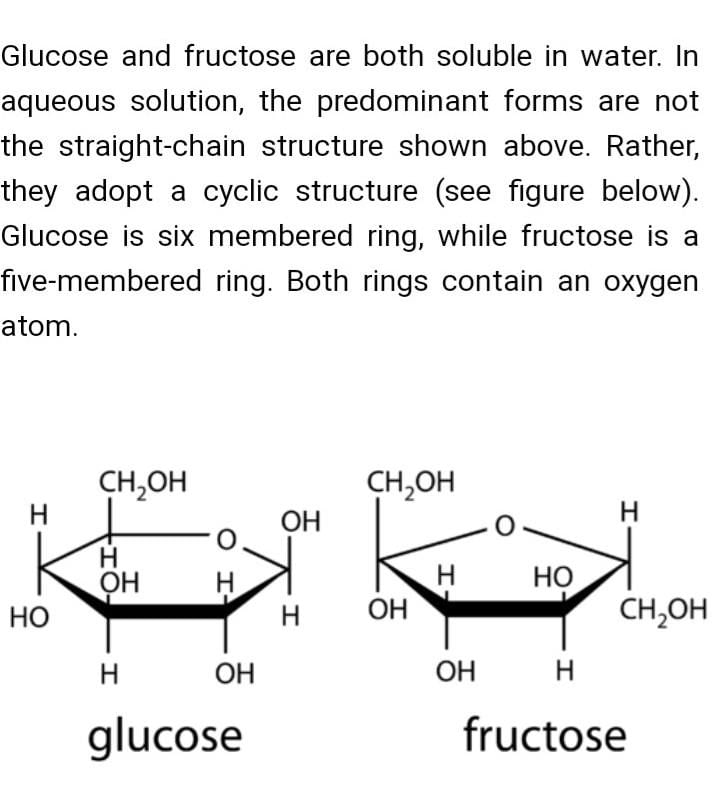Class 12 Exam > Class 12 Questions > cyclic structure of gl Related: Cyclic Struc...
Start Learning for Free
cyclic structure of gl
?Most Upvoted Answer
cyclic structure of gl Related: Cyclic Structure of Glucose and Fruct...

Community Answer
cyclic structure of gl Related: Cyclic Structure of Glucose and Fruct...
Cyclic Structure of Glucose
Glucose is a simple sugar (monosaccharide) that primarily exists in a cyclic form in solution. The cyclic structure of glucose is formed through a reaction between the aldehyde group and a hydroxyl group.
- Formation of the Cyclic Structure:
- Glucose has six carbon atoms, and its linear form features an aldehyde group at the first carbon.
- When glucose cyclizes, the carbonyl carbon (C1) reacts with the hydroxyl group on C5, forming a hemiacetal.
- Types of Cyclic Forms:
- Glucose can form two cyclic structures:
- Alpha (α) Glucose: The hydroxyl group on C1 is below the plane of the ring.
- Beta (β) Glucose: The hydroxyl group on C1 is above the plane of the ring.
- Ring Size:
- The cyclic form is a six-membered ring, known as a pyranose.
Cyclic Structure of Fructose
Fructose, another important monosaccharide, primarily exists as a five-membered ring in its cyclic form.
- Formation of the Cyclic Structure:
- Fructose has a ketone group at C2, which reacts with the hydroxyl group on C5, resulting in a hemiketal.
- Types of Cyclic Forms:
- Fructose can also form two isomeric cyclic structures:
- Alpha (α) Fructose: The hydroxyl group on C2 is below the plane of the ring.
- Beta (β) Fructose: The hydroxyl group on C2 is above the plane of the ring.
- Ring Size:
- The cyclic form is a five-membered ring, known as a furanose.
Conclusion
Understanding the cyclic structures of glucose and fructose is crucial for studying their biochemical roles, including their involvement in energy metabolism and carbohydrate chemistry.
Glucose is a simple sugar (monosaccharide) that primarily exists in a cyclic form in solution. The cyclic structure of glucose is formed through a reaction between the aldehyde group and a hydroxyl group.
- Formation of the Cyclic Structure:
- Glucose has six carbon atoms, and its linear form features an aldehyde group at the first carbon.
- When glucose cyclizes, the carbonyl carbon (C1) reacts with the hydroxyl group on C5, forming a hemiacetal.
- Types of Cyclic Forms:
- Glucose can form two cyclic structures:
- Alpha (α) Glucose: The hydroxyl group on C1 is below the plane of the ring.
- Beta (β) Glucose: The hydroxyl group on C1 is above the plane of the ring.
- Ring Size:
- The cyclic form is a six-membered ring, known as a pyranose.
Cyclic Structure of Fructose
Fructose, another important monosaccharide, primarily exists as a five-membered ring in its cyclic form.
- Formation of the Cyclic Structure:
- Fructose has a ketone group at C2, which reacts with the hydroxyl group on C5, resulting in a hemiketal.
- Types of Cyclic Forms:
- Fructose can also form two isomeric cyclic structures:
- Alpha (α) Fructose: The hydroxyl group on C2 is below the plane of the ring.
- Beta (β) Fructose: The hydroxyl group on C2 is above the plane of the ring.
- Ring Size:
- The cyclic form is a five-membered ring, known as a furanose.
Conclusion
Understanding the cyclic structures of glucose and fructose is crucial for studying their biochemical roles, including their involvement in energy metabolism and carbohydrate chemistry.

|
Explore Courses for Class 12 exam
|

|
Similar Class 12 Doubts
Question Description
cyclic structure of gl Related: Cyclic Structure of Glucose and Fructose? for Class 12 2025 is part of Class 12 preparation. The Question and answers have been prepared according to the Class 12 exam syllabus. Information about cyclic structure of gl Related: Cyclic Structure of Glucose and Fructose? covers all topics & solutions for Class 12 2025 Exam. Find important definitions, questions, meanings, examples, exercises and tests below for cyclic structure of gl Related: Cyclic Structure of Glucose and Fructose?.
cyclic structure of gl Related: Cyclic Structure of Glucose and Fructose? for Class 12 2025 is part of Class 12 preparation. The Question and answers have been prepared according to the Class 12 exam syllabus. Information about cyclic structure of gl Related: Cyclic Structure of Glucose and Fructose? covers all topics & solutions for Class 12 2025 Exam. Find important definitions, questions, meanings, examples, exercises and tests below for cyclic structure of gl Related: Cyclic Structure of Glucose and Fructose?.
Solutions for cyclic structure of gl Related: Cyclic Structure of Glucose and Fructose? in English & in Hindi are available as part of our courses for Class 12.
Download more important topics, notes, lectures and mock test series for Class 12 Exam by signing up for free.
Here you can find the meaning of cyclic structure of gl Related: Cyclic Structure of Glucose and Fructose? defined & explained in the simplest way possible. Besides giving the explanation of
cyclic structure of gl Related: Cyclic Structure of Glucose and Fructose?, a detailed solution for cyclic structure of gl Related: Cyclic Structure of Glucose and Fructose? has been provided alongside types of cyclic structure of gl Related: Cyclic Structure of Glucose and Fructose? theory, EduRev gives you an
ample number of questions to practice cyclic structure of gl Related: Cyclic Structure of Glucose and Fructose? tests, examples and also practice Class 12 tests.

|
Explore Courses for Class 12 exam
|

|
Signup to solve all Doubts
Signup to see your scores go up within 7 days! Learn & Practice with 1000+ FREE Notes, Videos & Tests.















